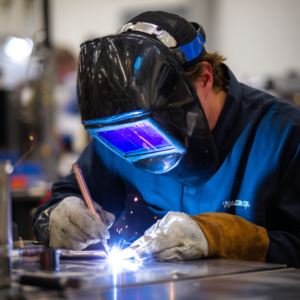
Understanding What Are Welding Certificate Programs and Their Value
Good news! If you’re curious about boosting your welding skills for specialized processes like GTaw (Gas Tungsten Arc Welding), you are in the right place. More and more companies, including those in pressure vessel fabrication, see formal training as a must-have. In fact, Red River, an ASME certified pressure vessel manufacturer, invests in comprehensive welding certificate programs that teach cutting-edge techniques and foster a culture of safety. Below, you will find a clear and balanced look at what are welding certificate programs are, why they matter, and how you can choose the best path forward.
Defining what are welding certificate programs
Welding certificate programs are focused training courses that teach essential welding techniques, safety protocols, and proper equipment use. Unlike traditional degrees, these programs emphasize hands-on skills over general education. At companies like Red River, training reflects real industry applications, especially in pressure vessel fabrication, so students gain job-ready experience without unnecessary coursework.
Why they matter for GTaw welding certification
GTAW welding certification requires precision, heat control, and a deep understanding of materials, skills that welding certificate programs are built to develop. These programs offer guided instruction in tungsten use, shielding gas handling, and joint preparation, with hands-on labs simulating real-world conditions. This makes them critical for anyone preparing to meet industry standards in fields like oil, gas, or custom fabrication.
Common skills and training methods
Students in welding certificate programs learn through a mix of classroom instruction and shop floor practice. They develop skills in reading blueprints, adjusting angles and current settings, and working with various metals like stainless and carbon steel. Soft skills such as teamwork and communication are also emphasized, with trainers at Red River highlighting the value of attitude, accountability, and consistency in producing quality welds
Linking theory and practice
Programs bridge theory and hands-on application by helping students spot and fix welding mistakes in real time. Instructors guide learners through practical welds, using visual and bend tests to evaluate performance. These repeated exercises build a portfolio of tested work, giving students the confidence and proof of skill needed to impress future employers or pass certification exams.
Pick the right program for you
Choosing a welding certificate program can feel overwhelming. You might wonder which curriculum suits your level, how much time you should invest, and what sort of accreditation the institution holds. Here, a few clear steps can help:
- Check accreditation: Look for programs affiliated with respected groups, like the American Welding Society (AWS). This ensures your training meets recognized quality standards. Red River itself is an AWS member, which says a lot about the esteem and rigor of such credentials.
- Examine the syllabus: Compare course outlines. Does your program cover theory, lab work, and safety training? If you plan to pursue advanced processes like GTAW welding certification, make sure it devotes ample time to that method.
- Consider your schedule: Some welding certificate programs offer flexible tracks with evening or weekend classes. Decide if you need a fast-paced environment or a slower approach to learn at your own speed.
- Review the facility and instructors: A well-maintained workshop with up-to-date equipment can make a big difference. Ask how many hours of hands-on training you will get, and verify the instructors’ experience in the field.
- Look for industry connections: Programs connected to active manufacturers, such as Red River, often provide direct pipelines to real-world projects. You will have a better chance to apply what you learn and get feedback from industry professionals.
Taking the time to evaluate these factors pays off. You might find specialized training that gives you a competitive edge if you plan to work in critical environments like pressure vessel fabrication.
See how prefabrication boosts training
Prefabrication is a technique where large parts of a project, such as sections of piping or entire pressure vessels, are built in a controlled off-site facility. This approach also influences the kind of training you will receive in a welding certificate program.
Fewer exposure hours, better focus
Working off-site in a controlled environment reduces the time you spend in potentially hazardous conditions. Red River highlights that prefabrication cuts the total number of exposure hours on active job sites. This improves safety statistics and streamlines your training. You will spend more energy perfecting each weld rather than juggling the logistical challenges of a busy construction area.
Emphasis on quality and traceability
Prefabrication often requires precise weld tracking. In top-tier facilities, each weld can be documented along with the welder’s name, the type of filler material, and the machine settings. You learn to master record-keeping as part of your welding certificate program. Having this skill set means you will be comfortable with rigorous standards especially important when clients insist on full traceability, as seen in ASME-certified pressure vessel manufacturing.
Faster turnaround, real-world perspective
When the main fabrication happens in a manufacturing facility, weather delays or scheduling conflicts on-site become less disruptive. You stay hands-on with the welds, which can then be shipped to the final site and installed quickly. Some certificate courses show you how to handle kitting, shop drawings, and isometrics in real time. That level of readiness is a major plus if you hope to support large-scale builds someday.
Tie-in with advanced methods
Prefabrication demands welders who can adapt to specialized materials and layouts. This is especially true for advanced methods like GTAW. Because GTAW is often crucial for high-precision areas, think pressure vessels that contain volatile substances, and you will refine your ability to achieve leak-proof, structurally sound welds. Many welding certificate programs teach you to adapt your methods to different tasks, so you are ready to tackle complex prefabricated assemblies with confidence.
What Are Welding Certificate Programs
Welding certificate programs are structured, skill-focused courses that help you become a credible welder. They blend core theory with hands-on practice, placing a strong emphasis on meticulous craftsmanship and safety. By choosing a program that aligns with industry standards especially if you aim to pursue advanced techniques like GTAW welding certification, you gain a solid launchpad for in-demand roles. At Red River, we see firsthand how this training supports not just a single project but an entire career path in high-quality fabrication.
Investing in a welding certificate program sets you up to meet industry benchmarks and earn professional validation for your expertise. You can then tackle specialized challenges, including ASME pressure vessels knowing you have both the background and the applied skillset to ensure top-notch results.
Enroll in Welding Certificate Programs Today
Don’t wait to advance your career. Enroll in welding certificate programs now to gain skills, build confidence, and earn the credentials that employers are looking for. Start today and move toward a stronger future in welding.
Frequently asked questions
1. How long do most programs take to complete?
Program length varies widely. Some can be completed in six weeks, while more comprehensive courses might last a year. To learn more, check how long are welding certificate programs.
2. Where to find welding certificate programs?
Welding certificate programs are offered at U.S. community colleges, technical schools, trade unions, and accredited private training centers. Organizations like AWS and ASME also partner with institutions to offer standardized certification pathways.
3. Do I need welding experience to begin these programs?
Many programs welcome beginners, offering a step-by-step curriculum from basic to advanced. You do not always need previous experience. Instructors often start with safety fundamentals, then move into procedures tailored to your level.
4. Does completing a program pressure me to jump straight into production work?
Not necessarily. Many graduates do choose to go straight into the field, but completing a certificate simply opens the door. You can move forward with advanced training, pursue a specific certification test, or transition into more specialized areas like welding certification training.
5. How do I know if a program’s certificate is recognized?
Check the program’s affiliations, such as American Welding Society membership or ASME-related approvals. A recognized institute usually details its accreditation on its official page or marketing materials.
Your key takeaways
- Welding certificate programs focus on practical skills, building your confidence through hands-on work.
- GTAW welding often appears in advanced settings, so specialized training can set you apart.
- Prefabrication methods reduce on-site risks, making your training safer and more efficient.
- Look for courses with strong industry connections. This ensures your skills match real-world requirements.
- High-quality documentation methods learned during training will help when working on ASME-level projects.
Related Blog Post

Where to Get Welding Certification Online for Your Career

How to Get Welding Certification Online Without Breaking a Sweat

Can You Get Welding Certification Online? Here’s the Truth

Why You Should Consider Welding Certification Online

Where to Find Welding Certificate Programs
No related articles found.
